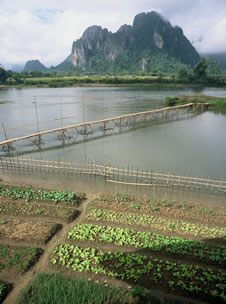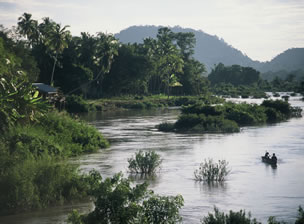"Laos: A Southeast Asian Gem"
Newspaper story & fine art photographs by: Brad Carlile
Freeport Journal Standard, 20-Feb-2003 p. C7
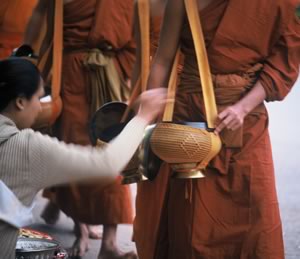
In the cool of the morning the clouds cling to the hills surrounding the lushly green city. At 6AM, I kneel on the sidewalk next to an old woman who shows me how to place tiny sticky-rice offerings in the brass pots of the swiftly passing orange-robed monks. The woman's only English is the word "monk". The remainder of her instructions are done in pantomime. Participating in their daily ritual is how my first morning started in the city of Louang Phabang in Laos (pronounced Lao, without an "s").
Many well-seasoned travelers will tell you that Laos is one of their favorite places. What is it about this land-locked country between Thailand, Myanmar, China, Viet Nam, and Cambodia? Is it the beautiful waterfalls, the emerald hills, the majestic rivers, the graceful temples, the vibrant culture, relaxed pace of life, delicious food, or the friendly smiling people? It is the subtle combination of all of these and so much more that make Laos a southeast Asian gem.
Now is a great time to explore and enjoy Laos. Laos is a tropical Asian country that is about twice the size of Illinois. There are many different things to do and see here. For those worried about foreign travel, there are few post 9-11 issues for travelers. Laos is predominantly Buddhist and there is a lack of American symbols to attack.
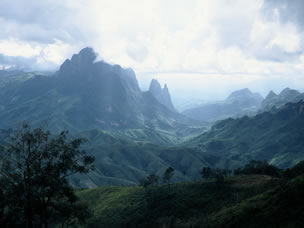
Sabaidi
"Sabaidi" (pronounced sa-buy-dee) is the Lao greeting that is always accompanied with a smile. Much like aloha it means "hello"," good bye", "I'm well", "welcome", and much more. A wonderful part of the culture is the smiles and enthusiasm the Lao have when they greet anyone. This warm spirit goes beyond greetings and their hospitality makes visitors feel welcome. I found everyone to be very friendly.
Life moves at a slower pace in Laos. Time is always made for smiles, conversation, and news about families. At social gatherings the love of conversation and fun is clear.
Northern Laos
The first part of my trip was an 11-day loop through the towns and villages of northern Laos. Visiting smaller towns are a great way to experience the more traditional life. In addition, I heard that a once-a-year festival was soon to occur in one of these towns called Muang Sing. I adjusted my plans to participate in the festivities.
I used the same transport as the locals to get from place to place. It was easy to learn how to get around. Roads in Laos range from smooth modern roads to bumpy dusty-red dirt tracks. Sitting on hard benches while bouncing down a rough road in the back of a covered small truck is not always comfortable, but it gives one time to get to know your fellow passengers. This more than makes up for the slight discomforts. Other more comfortable transportation options are available, but they also insulate one from the local culture.
Nam Ou River Journey to Muang Sing
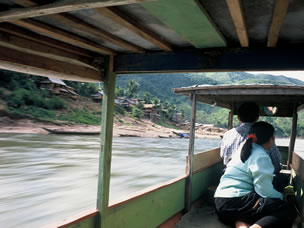
My first stop was the lovely town of Nung Khiaw which overlooks the Nam Ou river. In this mountainous country, rivers provide many important things like irrigation, food and transportation. For the next leg of the journey I opted for the slow boat up the Nam Ou River. Slow boats allow one to soak in the changing views of the country-side. The boat moves upstream in water that is sometimes smooth as glass and sometimes covered with rapids and whirlpools.
The boat makes stops at several small villages to pick up or drop off people and produce. Each stop and every interaction provides more opportunities to learn more about Laos.
Laos has its share of problems typical of the Third World. These problems also include a nasty legacy of the Viet Nam war. Signs still hang in villages throughout Laos giving diagrams of various bombs so the people can recognize them and avoid them.
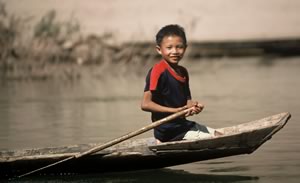
During the Vietnam War, the Vietnamese and later the Americans violated the Geneva accords. In a "secret war" from 1964-1973, Laos was the most heavily bombed country per capita. A sortie was flown on average every 8 minutes around the clock during those years. About 30% of these bombs did not explode. With an average density of 7 tons per square mile, Laos is literally covered with unexploded ordinance (UXO). UXO is a huge barrier to development in Laos and bombs still kill one person every 3 days. For more information see uxolao.gov.la (UXOLao). The towns and tourist sites are free of this problem, so this is not an issue for tourists staying on the beaten path.
Muang Sing and Full Moon Festival (That Xieng Tung)
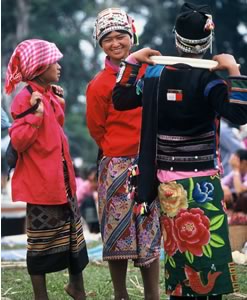
My loop eventually brought me to the northern town of Muang Sing, in time for the festival. This area has many distinct ethnic groups each with their own traditions. Culturally-sensitive guided treks can be hired to take one through ethnic Hmong, Akha, Yao, and Lu villages. Arriving a day before the event allowed me to explore many of the ethnic villages nestled in the surrounding hills. Life is simple in these farming villages and the woman all wear beautiful traditional clothes particular to their ethnic group.
At the invitation of a couple of Akha men, I took a turn using a two-man handsaw to saw a plank from a log. They thought it was pretty funny that I actually helped. They only see westerners visiting and never doing anything resembling work.
Many villagers are reserved with outsiders, but become very friendly especially after we start joking around. I show the children the illusion of pulling off the thumb that my dad taught me as a kid. That trick got them all laughing.
The full moon on the 12th lunar month heralds the start of the "That Xieng Tung" festival in Muang Sing in northern Laos. More than 2,000 people come to enjoy this festival from throughout the province and even nearby China.
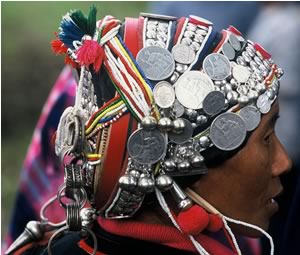
This festival is a wonderful blend of Buddhist ceremony and county fair. A highlight of this festival for me was a chance to see the wide range of traditional attire. As with people everywhere,parties bring out the most beautiful clothes.
A golden Buddhist stupa on a prominent hill is the site for the festival. Three clockwise trips around the stupa guarantees some of my karma for a while. Anyone with an offering of flowers, incense, and candles can take part.
Like any festival, there are all kinds of activities including carnival games, music, dance, and fireworks. I joined in on several carnival games including the dart game and the bingo but unfortunately I was not skillful enough to win the coveted prizes.
Mekong River
To finish off this loop I traveled to the Mekong River (pronounced" May-kong") which forms the border between Thailand and Laos. For many tourists the two-day trip down the Mekong river to Louang Phabang is the first introduction to Laos. This trip is also a highlight for many travelers.
Louang Phabang
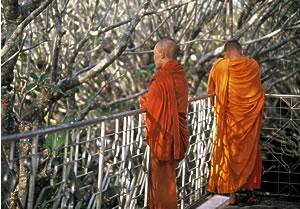
Louang Phabang is the defacto cultural capitol of Laos. It is now a world heritage site and many efforts are being made to preserve both the dozens of Buddhist temples and classic French-colonial architecture that are spread throughout the city.
At sunset gardens and the tree-lined streets give Louang Phabang a tranquil feeling. Majestic panoramic views abound from the Buddhist temple perched on top of Phou Si hill in the center of town. Day trips to beautiful waterfalls and nearby villages make Louang Phabang a great base for several days of wandering.
Louang Phabang is known for its centuries of cultural contributions throughout Laos. These have taken place in the form of art, dance, textiles, its prized food, and many more.
